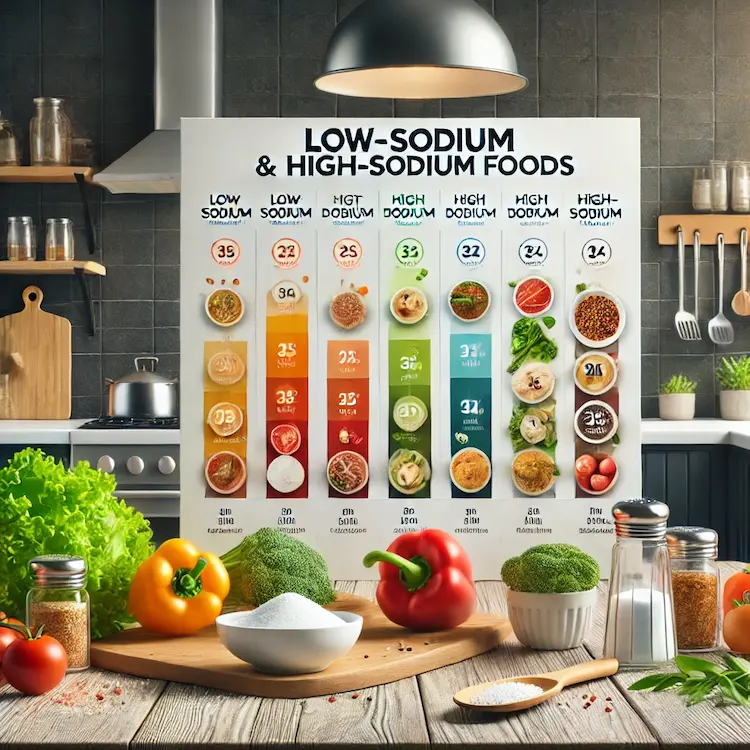High blood pressure, or hypertension, is a leading cause of cardiovascular diseases globally. One significant contributor to elevated blood pressure is excessive sodium intake. This article explores how reducing sodium intake effect on blood pressure, breaking down the topic into detailed sections with practical advice and actionable insights.
Understanding Sodium and Blood Pressure
What is Sodium?
Sodium is an essential mineral that helps regulate fluid balance, nerve function, and muscle contractions. However, excessive intake can disrupt the body’s fluid balance, leading to health issues.

How Sodium Affects Blood Pressure
When sodium levels are high, the body retains more water to dilute the excess. This increases blood volume, putting added pressure on blood vessel walls, which can lead to hypertension over time.
Importance of Reducing Sodium Intake
Health Benefits
- Lower Blood Pressure: Studies show that reducing sodium intake can lower systolic blood pressure by 5–6 mmHg and diastolic pressure by 2–3 mmHg.
- Reduced Risk of Cardiovascular Diseases: Decreasing sodium reduces the likelihood of heart attacks, strokes, and kidney disease.
- Improved Overall Health: Lower sodium levels contribute to better kidney function and less fluid retention.
Societal Impact
Countries with national sodium reduction programs have seen significant decreases in hypertension cases, reducing healthcare costs and improving public health.
Daily Sodium Recommendations
Guidelines from Leading Health Organizations
- World Health Organization (WHO): Recommends less than 5 grams of salt (approximately 2 grams of sodium) daily.
- American Heart Association (AHA): Advises limiting sodium intake to 1,500 milligrams per day, especially for those with high blood pressure.
Current Sodium Consumption
Most people consume more than double the recommended sodium levels, largely from processed foods and restaurant meals.
Methods to Reduce Sodium Intake
Reading Food Labels
- What to Look For: Sodium content is often listed in milligrams. Aim for products labeled as “low sodium” (140 mg or less per serving).
- Practical Tip: Avoid items with more than 20% of the daily value for sodium per serving.
Cooking at Home
- Benefits: Home-cooked meals give you control over ingredients.
- Tips:
- Use herbs and spices for flavor instead of salt.
- Avoid pre-packaged seasoning mixes high in sodium.
Choosing Low-Sodium Alternatives
- Examples:
- Opt for fresh or frozen vegetables instead of canned varieties.
- Use unsalted butter or low-sodium broths.
Limiting Processed Foods
Processed foods contribute to 70–80% of sodium intake. Reducing reliance on fast food, packaged snacks, and processed meats can significantly lower sodium levels.
Comparison of Approaches
| Method | Ease of Implementation | Effectiveness in Reducing Sodium | Cost |
|---|---|---|---|
| Reading Food Labels | Moderate | High | Low |
| Cooking at Home | High | Very High | Moderate |
| Choosing Low-Sodium Options | Moderate | Moderate | Moderate to High |
| Limiting Processed Foods | High | Very High | Low to Moderate |
Practical Steps for Sodium Reduction
- Gradual Reduction: Slowly decrease salt in recipes to allow taste buds to adjust.
- Flavor Substitutes: Incorporate garlic, lemon juice, or vinegar as alternatives.
- Plan Meals: Create weekly menus to reduce reliance on high-sodium convenience foods.
- Stay Informed: Keep up-to-date with nutrition guidelines and food labeling laws.
Statistics on Sodium and Hypertension
- Global Data: The WHO estimates that reducing global sodium intake could prevent 2.5 million deaths annually.
- US Statistics: Approximately 47% of adults in the US have hypertension, with excessive sodium intake being a key factor.
- Clinical Evidence: A study in the New England Journal of Medicine demonstrated a 30% reduction in cardiovascular events among participants following a low-sodium diet.
Conclusion: Key Takeaways
Reducing sodium intake is a critical step in managing blood pressure and improving overall health. By making informed food choices, cooking at home, and avoiding processed foods, individuals can significantly lower their sodium consumption. For long-term benefits, gradual changes and consistent monitoring are essential.


